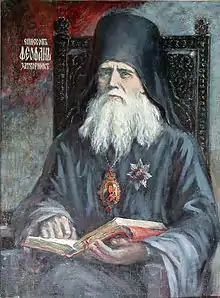Klobuk
A klobuk is an item of monastic clothing worn by Eastern Orthodox and Eastern Catholic monastics and bishops, especially in the Russian tradition. It is composed of a kamilavka (stiffened black headcovering, round and flat on the top) with an epanokamelavkion which completely covers the kamilavka and hangs down over the shoulders and back.


_by_shakko_02.jpg.webp)
Overview
In the Athonite tradition, the epanokamelavkion is simply laid over the kamilavka and allowed to hang freely,[1] but in other traditions it is permanently attached.[2]
The klobuk is the headgear most often worn in church by professed monastics. During the services, there are specified times when monks are to remove the klobuk and lay it on their left shoulder to denote reverence for the sacred (for instance, when the Priest brings the Chalice out through the Holy Doors for the distribution of Holy Communion during the Divine Liturgy). Nuns do not normally remove the klobuk at any time during services.[3]
The klobuk is often worn by bishops also. Diocesan bishops wear the simple monastic klobuk. Slavic Archbishops and Metropolitans usually wear a small jewelled cross on the front of their klobuk as a mark of their rank.[4] Metropolitans wear a klobuk that is white rather than black.[5]
The Patriarch of Romania wears a white klobuk as well as a white rason.[6] The Patriarchs of some Orthodox Churches (for example, the Patriarch of Moscow) wear a white headress similar to the klobuk that is rounded on top, decorated with embroidered images of seraphim, and surmounted with a cross.[7]
Patriarchs and bishops of the Coptic Catholic[8] and Armenian Catholic[9] churches wear klobuks as well, although it is not a headgear worn by their Oriental Orthodox counterparts. Red klobuks have been worn by a Coptic Catholic patriarch,[10] an Armenian Catholic catholicos,[11] and a Ukrainian Catholic major archbishop[12] after being elevated to the cardinalate. A purple klobuk has been used by a Ukrainian Catholic bishop.[13]
See also
Notes
- The Athonite Typicon calls for the veil to be removed at certain points during the services.
- A deacon's epanokamelavkion is normally removable because he serves wearing only the kamilavka when he vests.
- Even when nuns are to be anointed on the forehead, they do not remove the klobuk, only pushing it back on their heads enough for the priest or bishop to anoint them.
- . 2006-02-22 https://web.archive.org/web/20060222073606/http://ocaphoto.oca.org/filetmp/2005/May/1001/Detail/DSC_0002.jpg. Archived from the original on 2006-02-22. Retrieved 2020-03-22. Missing or empty
|title=(help) - . 2005-05-02 https://web.archive.org/web/20050502135421/http://www.oca.org/Images/HolySynod/portraits/met.theo.jpg. Archived from the original on 2005-05-02. Retrieved 2020-03-22. Missing or empty
|title=(help) - "Preoţi colaboratori ai fostei securităţi". bbc.co.uk. Retrieved 2020-03-22.
- https://www.loc.gov/exhibits/reflections/images/ref0026s.jpg. Missing or empty
|title=(help) - https://www.absolutviajes.com/wp-content/uploads/2010/12/IMG_017637.jpg. Missing or empty
|title=(help) - "big5.jpg (358x450 pixels)". archive.is. 2013-04-14. Retrieved 2020-03-22.
- http://i265.photobucket.com/albums/ii232/TERESA7_album/STEPHANOS-COPT.jpg. Missing or empty
|title=(help) - . 2004-04-15 https://web.archive.org/web/20040415204857/http://www.havelshouseofhistory.com/aghagianian%202.jpg. Archived from the original on 2004-04-15. Retrieved 2020-03-22. Missing or empty
|title=(help) - . 2007-01-28 https://web.archive.org/web/20070128145658/http://danielmitsui.tripod.com/sitebuildercontent/sitebuilderpictures/slipyj2.jpg. Archived from the original on 2007-01-28. Retrieved 2020-03-22. Missing or empty
|title=(help) - "Bishop Basil Losten in the purple headdress". www.brama.com. Retrieved 2020-03-22.
References
- Philippi, Dieter (2009). Sammlung Philippi - Kopfbedeckungen in Glaube, Religion und Spiritualität. St. Benno Verlag, Leipzig. ISBN 978-3-7462-2800-6.
External links
| Wikimedia Commons has media related to Klobuk. |